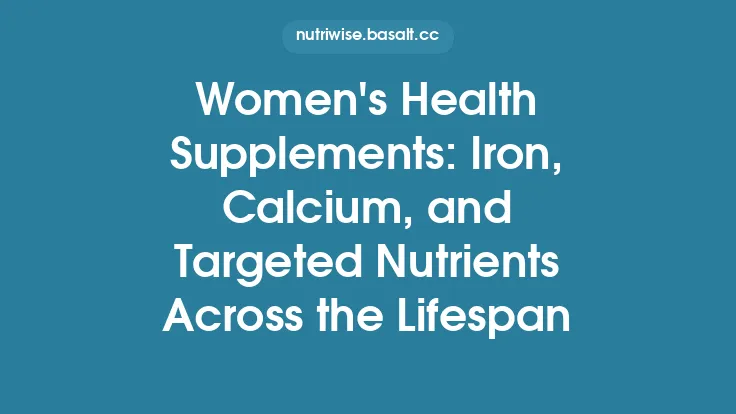Men’s health is shaped by a combination of hormonal balance, organ function, and lifestyle factors that evolve throughout adulthood. While a well‑rounded diet and regular exercise remain the foundation of optimal health, many men turn to targeted supplements to address specific concerns such as prostate wellness, muscle preservation, and sustained vitality. This article delves into the science behind the most researched nutrients for these areas, outlines practical dosing strategies, and highlights safety considerations so you can make informed choices that complement your overall health plan.
Understanding Men’s Unique Nutritional Demands
- Hormonal Landscape
Testosterone peaks in the late teens to early twenties and gradually declines by about 1 % per year after the age of 30. This natural ebb can affect muscle protein synthesis, libido, mood, and energy levels. Nutrients that support endocrine health—particularly those influencing the hypothalamic‑pituitary‑gonadal axis—can help mitigate the functional impact of this decline.
- Prostate Physiology
The prostate is a hormone‑responsive gland that enlarges in many men as they age, a condition known as benign prostatic hyperplasia (BPH). While BPH is not cancerous, it can cause urinary urgency, nocturia, and reduced quality of life. The prostate’s high concentration of zinc and its reliance on androgen signaling make it uniquely responsive to certain micronutrients and phytochemicals.
- Muscle Protein Turnover
Muscle mass is a dynamic balance between protein synthesis and breakdown. Age‑related anabolic resistance—where muscles become less responsive to protein intake and resistance training—necessitates higher quality protein sources, essential amino acids, and supportive co‑factors such as vitamin D and magnesium.
- Energy Metabolism
Mitochondrial efficiency, adrenal hormone output, and oxidative stress collectively dictate daily vigor. Nutrients that enhance mitochondrial ATP production, buffer oxidative damage, and modulate the stress response can sustain energy levels and mental sharpness.
Prostate Health Supplements
| Supplement | Primary Action | Typical Dose | Key Evidence |
|---|---|---|---|
| Saw Palmetto (Serenoa repens) | Inhibits 5‑α‑reductase, reducing DHT conversion; anti‑inflammatory | 320 mg standardized extract (≥ 85 % fatty acids) daily | Meta‑analyses show modest improvement in urinary flow and nocturia; benefits most evident in mild‑to‑moderate BPH |
| Beta‑Sitosterol | Competes with cholesterol for absorption; may reduce prostate volume | 60–130 mg twice daily | Randomized trials report decreased International Prostate Symptom Score (IPSS) and improved urine flow |
| Zinc (as zinc picolinate or citrate) | High concentration in prostatic fluid; supports antioxidant enzymes | 15–30 mg elemental zinc daily (max 40 mg to avoid copper depletion) | Low zinc status correlates with larger prostate volume; supplementation improves PSA stability in some studies |
| Selenium (as selenomethionine) | Cofactor for glutathione peroxidase; reduces oxidative stress | 100–200 µg daily (avoid > 400 µg) | Observational data link adequate selenium with lower BPH incidence; RCTs show mixed results, suggesting benefit when baseline status is low |
| Lycopene (from tomato extract) | Potent antioxidant; may inhibit prostate cell proliferation | 10–30 mg lycopene (equivalent to 2–4 cups cooked tomatoes) | Prospective cohort studies associate higher lycopene intake with reduced BPH progression |
| Vitamin D3 | Modulates androgen receptor activity; anti‑inflammatory | 2,000–4,000 IU daily (target serum 30–50 ng/mL) | Deficiency linked to higher PSA; supplementation improves urinary symptoms in deficient men |
Practical Tips
- Combine for Synergy: A blend of saw palmetto, beta‑sitosterol, and lycopene often yields greater symptom relief than any single agent.
- Timing: Fat‑soluble compounds (saw palmetto, lycopene, vitamin D) are best taken with a meal containing healthy fats.
- Monitoring: Check serum PSA and urinary flow metrics before starting and after 3–6 months of supplementation. Adjust doses based on response and any side effects (e.g., mild gastrointestinal upset with saw palmetto).
Muscle Maintenance and Recovery
| Nutrient | Role in Muscle | Recommended Form | Typical Dose |
|---|---|---|---|
| Whey Protein Isolate | Rapidly digestible source of essential amino acids (EAAs), especially leucine | Powder, mixed with water or milk | 20–30 g post‑exercise; 0.4 g/kg body weight on non‑training days |
| Creatine Monohydrate | Increases phosphocreatine stores, enhancing ATP regeneration during high‑intensity work | Micronized powder (to improve solubility) | 5 g daily (no loading phase required) |
| Branched‑Chain Amino Acids (Leucine ≥ 2 g) | Stimulates mTOR pathway, driving protein synthesis | Free‑form BCAA powder or within protein blends | 5–10 g pre‑ or intra‑workout; ensure ≥ 2 g leucine per dose |
| Beta‑Hydroxy‑β‑Methylbutyrate (HMB) | Reduces muscle protein breakdown, especially during caloric deficit | Calcium salt (HMB‑Ca) | 3 g daily, split into 1 g doses |
| Omega‑3 Fatty Acids (EPA/DHA) | Anti‑inflammatory; may improve muscle anabolic response | Fish oil triglyceride or re‑esterified form | 1–2 g EPA + DHA combined |
| Vitamin D3 | Supports muscle strength and function via VDR signaling | Same as prostate section | 2,000–4,000 IU daily |
| Magnesium (as magnesium glycinate) | Cofactor for ATP synthesis; reduces cramping | Chelated form for better absorption | 300–400 mg elemental magnesium daily |
Implementation Strategies
- Post‑Workout Window: Consume whey protein (20–30 g) with 5 g creatine within 30 minutes of training to maximize muscle protein synthesis and replenish phosphocreatine stores.
- Daily Consistency: Creatine, omega‑3s, vitamin D, and magnesium should be taken every day, regardless of training status, to maintain intracellular stores.
- Protein Distribution: Aim for 0.4 g/kg of high‑quality protein per meal across 3–4 meals to sustain a positive net protein balance throughout the day.
- Periodized Use of HMB: Consider HMB during phases of high volume, caloric restriction, or when returning from injury, as it can blunt muscle loss.
Supporting Energy, Mood, and Overall Vitality
| Ingredient | Mechanism | Typical Dose | Evidence Highlights |
|---|---|---|---|
| Coenzyme Q10 (Ubiquinol) | Electron carrier in mitochondrial respiratory chain; antioxidant | 100–200 mg daily (ubiquinol form for better absorption) | Improves exercise capacity and reduces fatigue in men with low baseline levels |
| Ashwagandha (Withania somnifera) – KSM‑66 extract | Adaptogen; modulates cortisol, enhances testosterone | 300–600 mg daily (standardized to ≥ 5 % withanolides) | RCTs show ↑ testosterone (≈ 10 %) and ↓ stress scores |
| Rhodiola Rosea (standardized 3 % rosavins, 1 % salidroside) | Increases catecholamine release, improves mental endurance | 200–400 mg daily | Improves perceived energy and reduces mental fatigue during prolonged tasks |
| B‑Complex (Methylated forms: methylcobalamin B12, methylfolate B9) | Cofactors in energy metabolism (TCA cycle, electron transport) | B12 500–1,000 µg; B6 25 mg; B9 400 µg daily | Deficiency linked to low energy; supplementation restores normal homocysteine and improves vigor |
| Panax Ginseng (standardized to 4 % ginsenosides) | Stimulates adrenal cortex, enhances nitric oxide production | 200–400 mg daily | Meta‑analysis shows modest improvements in physical performance and subjective energy |
| L‑Citrulline | Precursor to arginine → nitric oxide; improves blood flow to muscles and brain | 3–6 g daily (often combined with malate) | Enhances aerobic performance and reduces post‑exercise soreness |
Guidelines for Use
- Morning Stack: Combine a B‑complex, CoQ10, and ashwagandha with breakfast to support cortisol regulation and mitochondrial function throughout the day.
- Pre‑Workout Boost: Take citrulline (3 g) 30 minutes before activity, optionally paired with rhodiola for mental focus.
- Evening Considerations: Ginseng and high‑dose rhodiola can be stimulating; schedule them earlier in the day to avoid sleep disruption.
- Cycle Adaptogens: Use ashwagandha and rhodiola for 6–8 weeks, then pause for 2 weeks to prevent tolerance buildup.
Integrating Supplements into a Daily Routine
- Create a Structured Schedule
- Breakfast: B‑complex, vitamin D, omega‑3, probiotic (if used)
- Pre‑Workout (30 min prior): Citrulline, BCAA or leucine, optional rhodiola
- Post‑Workout: Whey protein + creatine + HMB (if in a cutting phase)
- Lunch/Dinner: Saw palmetto blend, lycopene, zinc, magnesium (with food)
- Evening: Ashwagandha (if using a calming formulation) or CoQ10
- Food Pairing for Optimal Absorption
- Fat‑Soluble Nutrients (vitamin D, lycopene, saw palmetto) → take with meals containing healthy fats (avocado, nuts, olive oil).
- Minerals (zinc, magnesium) → avoid high‑phytate foods (whole grains, legumes) in the same dose; separate by 2 hours if needed.
- Creatine → can be mixed with carbohydrate‑rich drinks to enhance uptake via insulin-mediated transport.
- Tracking and Adjusting
- Use a simple spreadsheet or health app to log supplement timing, dosage, and any subjective changes (energy, urinary symptoms, muscle soreness).
- Re‑evaluate blood markers (25‑OH vitamin D, serum zinc, PSA, testosterone) every 3–6 months to fine‑tune dosages.
Safety, Interactions, and Quality Assurance
| Concern | Detail | Mitigation |
|---|---|---|
| Potential Hormonal Effects | Saw palmetto and beta‑sitosterol modestly lower DHT; may affect libido in a minority of users. | Start with half the recommended dose; monitor sexual function; discontinue if adverse. |
| Zinc–Copper Balance | High zinc intake can induce copper deficiency, leading to anemia or neutropenia. | Keep zinc ≤ 40 mg/day and consider a low‑dose copper (0.9 mg) supplement if using zinc long‑term. |
| Creatine & Kidney Function | In healthy individuals, creatine is safe; however, those with pre‑existing renal disease should avoid high doses. | Obtain baseline serum creatinine and eGFR; stay within 5 g/day. |
| Vitamin D Toxicity | Excessive vitamin D (> 10,000 IU/day) can cause hypercalcemia. | Aim for 2,000–4,000 IU unless prescribed higher under medical supervision; monitor serum calcium. |
| Herb‑Drug Interactions | Saw palmetto may potentiate anticoagulants; ginseng can affect blood glucose control. | Review all prescription meds; consult a pharmacist if on warfarin, insulin, or antiplatelet agents. |
| Supplement Purity | Contamination with heavy metals, pesticides, or undeclared stimulants is a risk. | Choose products certified by third‑party programs (NSF, USP, Informed‑Sport). Verify batch testing results on the manufacturer’s website. |
Frequently Asked Questions
Q: Can I rely solely on supplements for prostate health?
A: Supplements can alleviate mild‑to‑moderate BPH symptoms, but they are not a substitute for medical evaluation. Persistent urinary issues warrant a urologist’s assessment to rule out infection, stones, or malignancy.
Q: How long before I’ll notice improvements in muscle recovery?
A: Creatine and whey protein typically show measurable gains in strength and reduced soreness within 4–6 weeks of consistent use. HMB may produce noticeable benefits in as little as 2 weeks, especially during calorie restriction.
Q: Is there a “one‑size‑fits‑all” dose for ashwagandha?
A: No. Individual response varies based on baseline cortisol, testosterone, and stress levels. Starting at 300 mg daily and titrating up to 600 mg after 2 weeks is a prudent approach.
Q: Should I cycle my adaptogens?
A: Periodic cycling (e.g., 6 weeks on, 2 weeks off) helps prevent receptor desensitization and maintains efficacy, especially for potent adaptogens like rhodiola and ashwagandha.
Q: Are there any red‑flag symptoms that require stopping a supplement?
A: Yes. New onset of severe gastrointestinal distress, unexplained swelling, rash, rapid heart rate, or changes in urine color should prompt immediate discontinuation and medical consultation.
Bottom Line
Targeted supplementation can be a valuable ally for men seeking to support prostate function, preserve lean muscle, and sustain daily vitality. By selecting evidence‑backed nutrients—such as saw palmetto, zinc, whey protein, creatine, and adaptogenic herbs—and integrating them thoughtfully into a balanced diet and exercise regimen, you can address the physiological shifts that accompany adult life. Always prioritize quality, monitor your body’s response, and collaborate with a healthcare professional when introducing new supplements, especially if you have underlying health conditions or take prescription medications. With a strategic, personalized approach, supplements become more than pills—they become a cornerstone of a proactive, health‑focused lifestyle.





